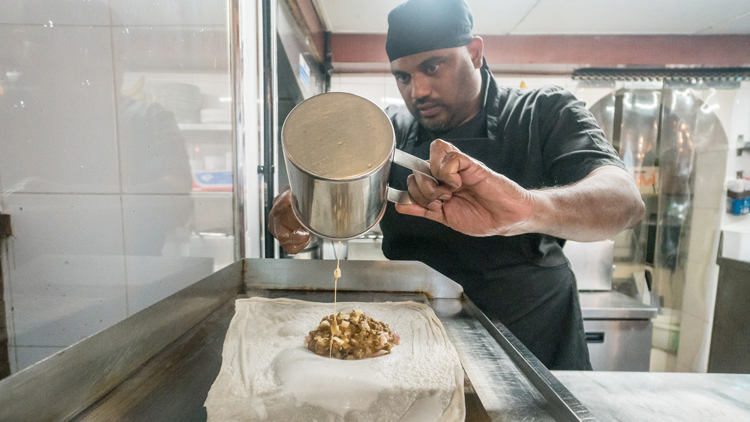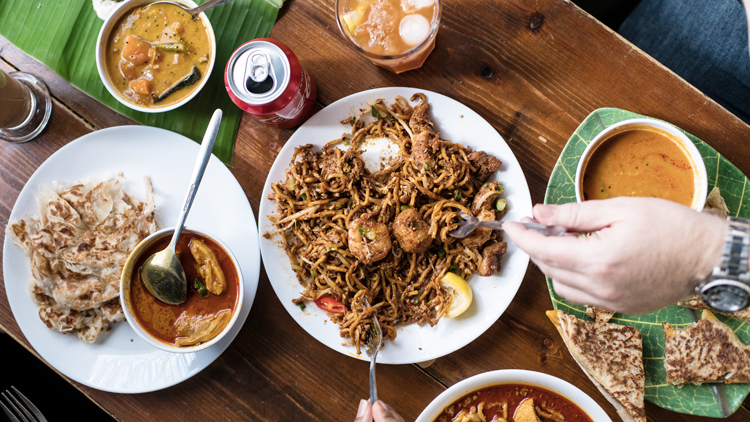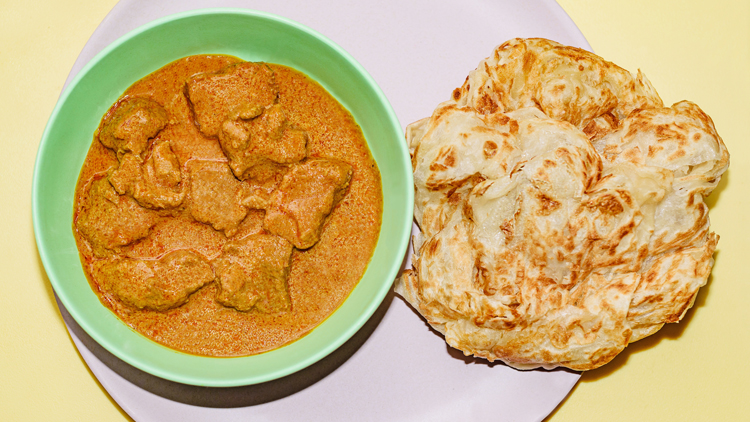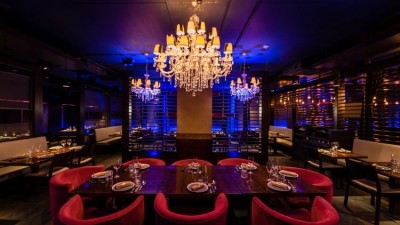Meet the Roti King
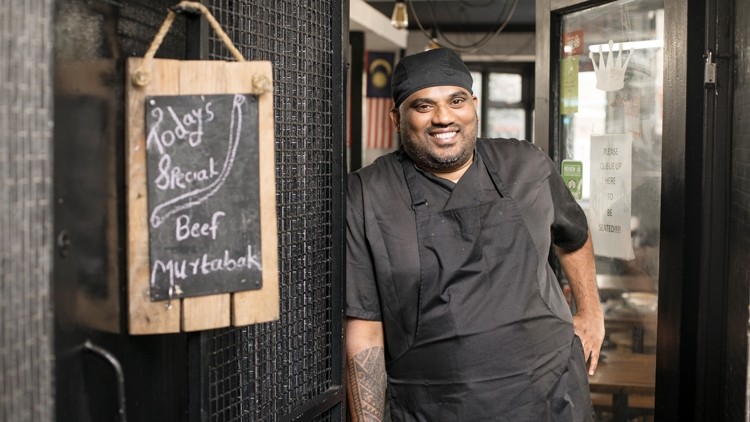
Kalpana Sugendran Sugendran also goes by a different, and equally impressive, name: he is better known as the ‘Roti King’. Not that Sugendran is in regal mode when we meet: it’s 1pm at Gopal’s Corner at Market Hall West End in London and he’s a staff member down. Sugendran, still in his outdoor coat, steps in to help. An hour (and several roti for me) later, we sit down to talk.
It’s apt that Sugendran is out of his comfort zone on this occasion, as it quickly becomes clear as he talks that he’s spent a lot of time there. The 41-year-old Malaysian Indian chef’s ascent has not been without obstacles since first coming to the UK in 1998 with plans to open a restaurant like that of his parents.
“Back home in Ipoh in the 1970s, they used to run a small little shop under the tree,” he says. “My dad used to buy fish heads that were 10p or 20p, and my mum would cook them for him.” One day a customer asked to try it and things took off from there, with the shop pivoting to a restaurant with curried fish head on the menu. “We’d sell 150 a day. That’s how we got really famous. Customers would come all the way from KL [Kuala Lumpur].”
On UK soil and thus without local connections (and the same sort of demand), Sugendran’s first attempt at restaurateur failed, with the chef moving back to Malaysia. Yet this setback – the first of a few – served only to galvanise him, with Sugendran returning to the UK five years later to set up Roti King at Oriental City (now Bang Bang Oriental) in north London’s Colindale in 2003.
Even then, the restaurant got off to an inauspicious start, Sugendran having just £80 in his pocket – not even enough to purchase a new griddle when the old one broke. “A customer asked me why I wasn’t serving my roti. He came to see me after lunch, gave me £500 and said ‘take this money, go buy a griddle. I want to eat your roti tomorrow.’”
This was to last five years until, in 2008 Oriental City was closed down by developers and Sugendran quit the industry almost entirely, taking on jobs as a dog-handler, in security and in a cemetery, just to feed the family. “The only thing I was adamant about was that I didn’t want to work in anyone else’s restaurant,” he says.
There were comebacks and guest appearances (at East Ham Market and at Trafalgar Square’s Malaysia Night) and he rented part of a shop in Chinatown, but it wasn’t until 2014 that he got his own place again when a friend with a struggling basement Chinese restaurant in Euston (aptly called Euston Chinese) handed over the keys along with the encouragement: “Take it, I know you can do it”.
Cue the same format: little funds meant Sugendran took on the business with meagre investment, not even changing the name to begin with (he has since given it Roti King branding) and editing laminated menus in pen to avoid having to pay to reprint them.
Then came the Hollywood moment, the one every chef dreams of: a rave review from a national critic, in this case, Marina O’Loughlin, then at The Guardian. “Sheer magic, and bewitching to watch”, she wrote of Roti King, (also adding “it’s enough to make a restaurant aesthete sob into his pressed-tin ceiling chart,” of the less than salubrious interior). “He’s a true craftsman...I can’t wait to go back.”
“I thank God for that,” says Sugendran of the review. “When the photographer came to take the pictures, she warned me to make sure I was ready.” Sugendran made three times the usual quantity of dough in preparation, but still it ran out. As did the curry. His pot washer no-showed, leaving Sugendran to wash up. “I was like ‘Oh my God, this is too much for me’. But I thought ‘No, this is what I wished for. I mustn’t complain.’”
Patience is paramount
It’s tempting to call this good fortune but Sugendran’s success is born not out of luck but of hard graft and talent. His bestseller is the eponymous roti canai, a paratha-like flatbread brought to Malaysia by Indian Muslims and named after Chennai in Tamil Nadu, which is eaten messily by being dunked into a bowl of curry dhall, chicken, lamb or fish. Sugendran has been making them since he was 14.
“I was taught by my uncle. The secret is having a lot of patience. You have to love the food. The only thing I know is how to make roti, so I make sure I do it properly.” At Roti King, he routinely makes 400 or 500 himself, though his personal best is 1,500. “If you’re really good, you can do 100 in an hour.”
What makes good roti? The recipe is simple: flour, salt, sugar, milk, water and “a lot of love”, he says. “It has to be really fluffy and crispy on top and not very thick, so if you eat one, you want to eat one more. You should still be enjoying it [to the last bite].” Freshness is paramount. “Some people keep the dough because they don’t want to throw it out but we always finish ours so we never get the chance.”
There’s more to Roti King’s menu than just two pieces of roti (the serving size) and a curry in which to dip it in. It also serves filled rotis, with either cheese; spinach and cheese; sardine; minced chicken and egg; and minced lamb and egg, as well local Malaysian dishes such as nasi goreng – stir fried rice with eggs, seafood, and chicken; beef rendang; and sambal fried rice as well as a selection of noodle dishes and stir fried vegetables. But the roti is undeniably king, also coming in sweet format with a caramelised banana filling; a sweet coconut jam filling; served with butter; and even in a cone shape with sugar sprinkles and vanilla ice cream.
Turning the Corner
With a hero product par excellence and O’Loughlin’s praise (Roti King would later feature in the restaurant critic’s top 10 UK restaurants alongside the likes of The Clove Club, The Quality Chop House and The Sportsman no less), Roti King is now firmly established in London’s restaurant scene. So much so that in 2018 Sugendran opened a second restaurant – Gopal’s Corner – at the Victoria venue of food hall concept Market Halls.
Named after his father, Gopal’s Corner is a return to the 1998 attempt to open a restaurant inspired by the one run by his parents in Malaysia. “It started under the tree back home,” says Sugendran of Gopal’s Corner, which was conceived for the launch of Market Hall Victoria.
The collaboration came about when Market Halls co-founder Simon Anderson, a fan of Roti King, approached Sugendran. “It was kind of a process to convince him,” recalls Anderson.
Market Halls worked with Sugendran to develop the concept and design the brand. Where Roti King serves Malaysian street food with its Malay, Chinese and Indian influences, Gopal’s Corner is more Malaysian Tamil, its hero dishes being roti canai and banana leaf platters comprising rice, vegetables and a choice of vegetable, meat or fish curries. Menu items also include thosai – savoury south Indian-style pancakes served with chutney and lentil stew; lamb chop satay; and laksa.
Such was the positive consumer response for the fresh approach that Anderson came knocking again when looking to open Market Hall West End at the tail end of last year. His belief in Sugendran has thus far been rewarded: Gopal’s Corner serves as many as 1,800 customers a week at Victoria and 1,500 customers a week at West End. “Gopal’s is the busiest trader at Victoria,” says Anderson. “At West End, it’s getting more of a run for its money. It’s quite a fun game for me to wind him up about it. He’s very competitive.”
Gopal’s Corner is a prime example of the two-way success of the food hall model. Sugendran’s reputation has been a draw for the food hall while Market Halls has helped him leverage his success. Anderson ascribes this success to, first and foremost, “the great product” at a good price point (£6.95 to £8.95 for the signature roti canai with dhal, chicken, mutton, or beef rendang, all halal). The theatrical aspect – with the roti makers stretching and flinging dough in the window – is another factor.
Rolling out more roti
The theatrics might be beneficial in creating a USP – especially when jostling for business with other traders under the same roof – but it is also a necessity that is not without its problems. As Sugendran’s business grows, finding skilled roti-makers is the most pressing challenge.
“We would like to bring people in who really love to do it. We can train people to make the roti, and teach them the recipes, but you need to know the colour, the smell. If they’re from Malaysia, I don’t have to tell them too much. To maintain the authenticity, you need at least one Malaysian chef.” To this end, he has applied for a sponsor license that will allow him to bring in chefs from Malaysia. He doesn’t expect it be easy, however, given that street food vendors don’t necessarily have formal qualifications. He’d like to introduce Ipoh-style chicken rice (distinct from the Hainanese version in that it features roast not poached chicken) and is in talks with a local ‘uncle’ (the colloquial term for a stall-holder) about working together.
In December, Sugendran established a central prep kitchen in Park Royal to make curries and dough for Roti King and Gopal’s Corner. A further site, called Roti Grill, is imminent with Sugendran poised to sign on a site in an upmarket London development in the coming weeks. There he’ll have an alcohol licence so will be able to serve wine and cocktails for the first time.
Any further sites Sugendran launches with Market Halls will be Gopal’s Corner, while standalone venues will be Roti King. The long-term plan is to have five or six in London – “one a year” – then one restaurant apiece in Manchester and Birmingham. “We are very happy with Market Halls,” smiles Sugendran. “Anywhere they go, if they want us, we’ll go.”
He won’t, however, lose site of the brand’s beginnings. “I want it to be affordable to anyone, especially students and working class people who can’t spend more than £15 or £20 a head.”
These are exciting times for the Roti King. Yet, with three children (7, 11 and 14) keeping him in check there’s little chance of him getting too big for his boots. “Someone asked for a selfie with me when I was out with my family the other day. My daughter asked me later ‘did you pay them?’” he laughs. And with that, the Roti King returns to the kitchen, where the griddle awaits.
This article first appeared in the February 2020 issue of Restaurant magazine, the leading title for the UK's restaurant industry. For more features, comment, interviews and in-depth analysis of the restaurant sector, subscribe to Restaurant magazine here.
Generation Next is a club for the rising stars in hospitality. For information on how to join or the next club events, contact jo.wattar@wrbm.com

